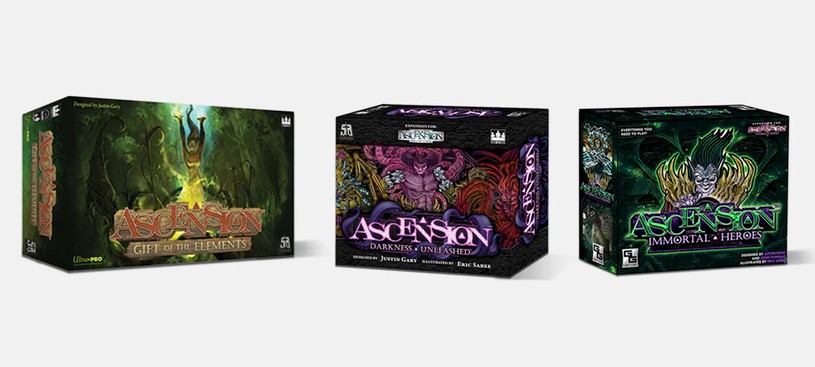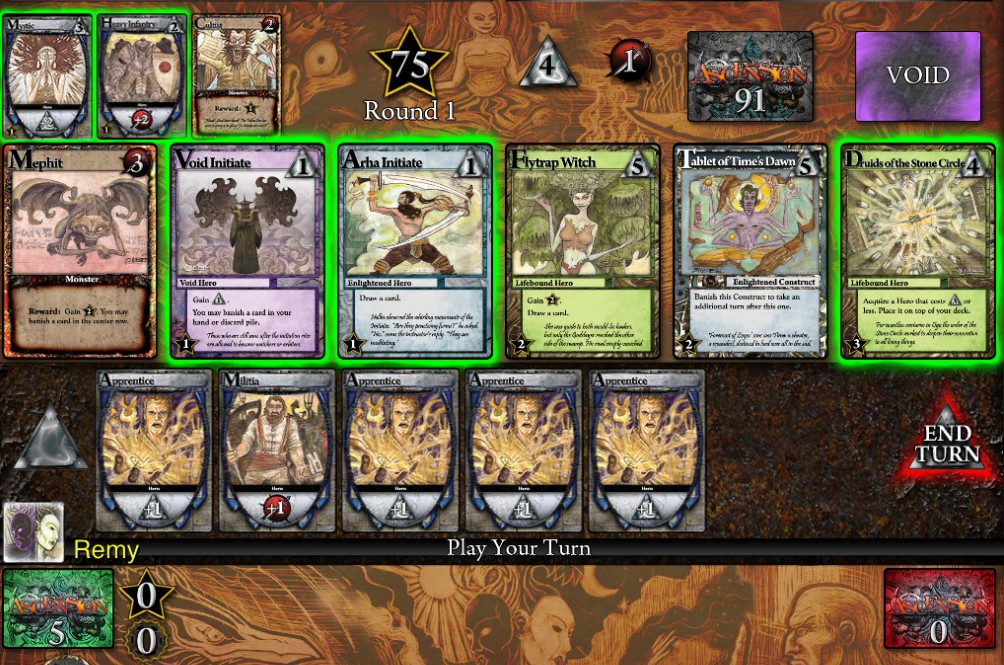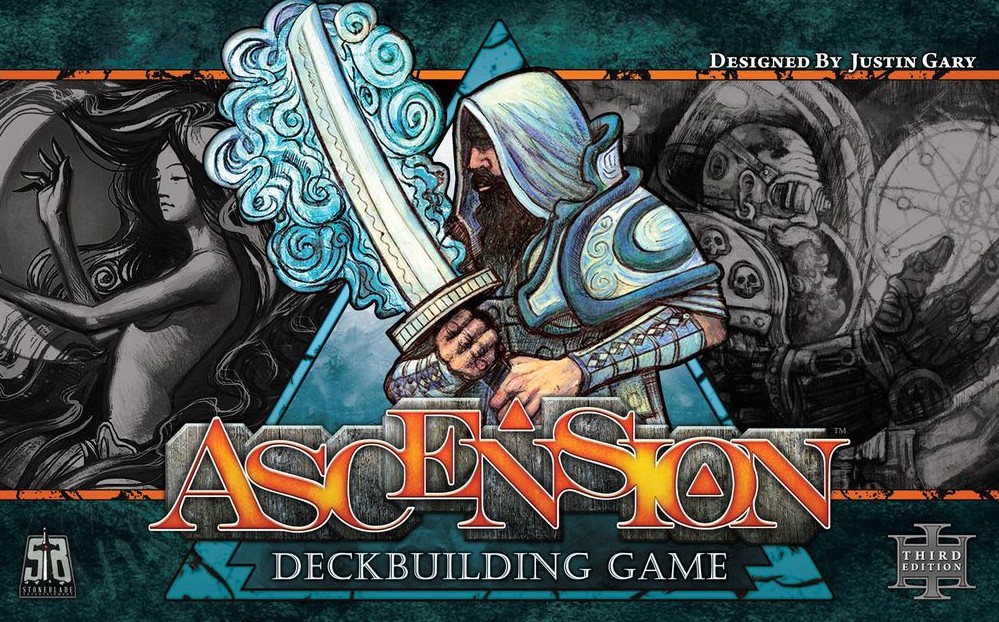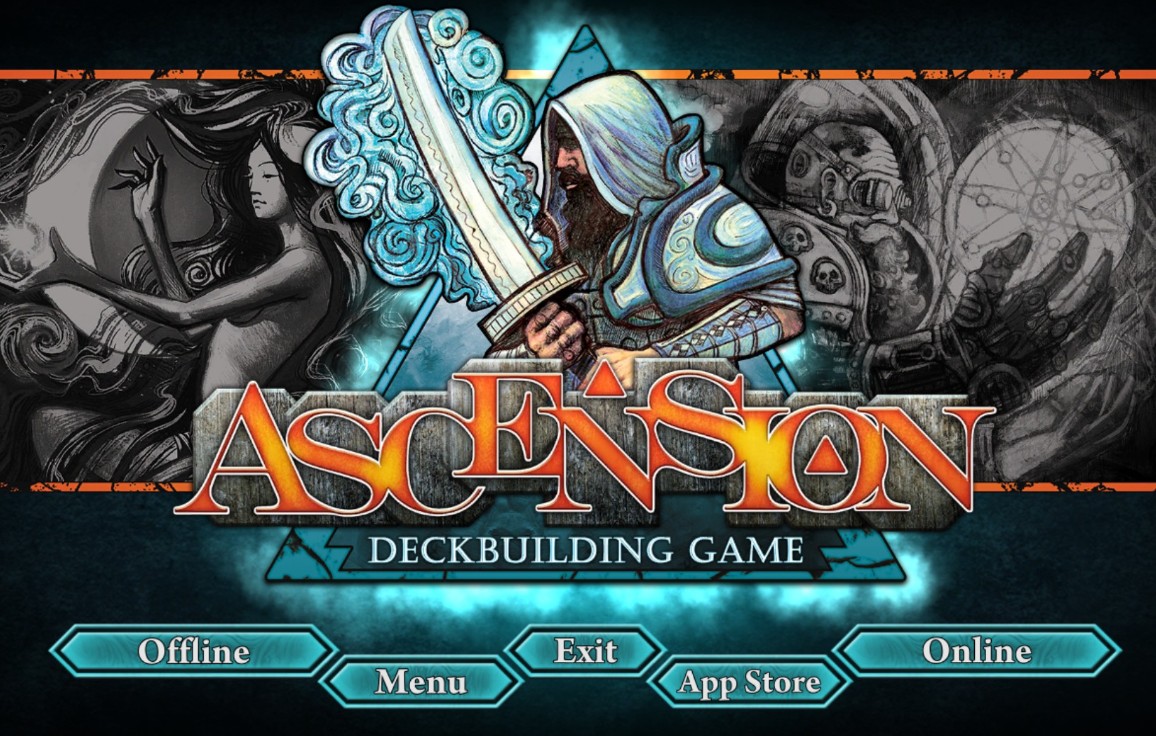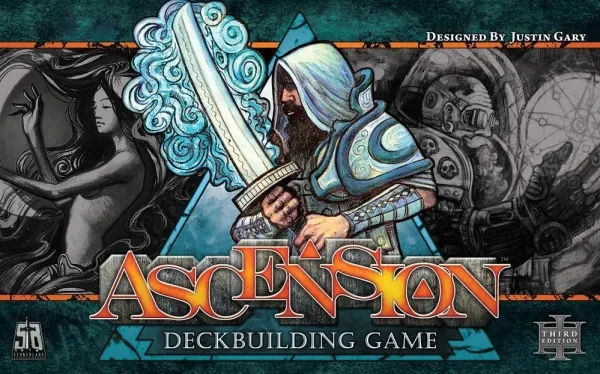
Discover the best strategies for Ascension: Deckbuilding Game.
#1: Drawing Cards is King:
Ascension is basically a game of efficiency. What you do in one single turn might not seems of a great impact, but it really adds up towards the end of the game. Taking this into account, what you want is that each single turn you are able to play the most powerful and useful cards in your deck. One of the best things to do so, is to draw many cards from your deck. To achieve this, you should consider obtaining heroes or defeating enemies that allow you to draw extra cards.
#2: Throw away the garbage:
Related to drawing cards, it doesn’t matter how many cards you draw per turn, if all those cards are useless or do not offer you enough utility or power. Here is where banishing cards comes into play. As you keep banishing low level cards from your deck, only the most useful ones will be left, guaranteeing you that only these powerful cards will come into your hand.
#3: 1-rune-cost traps:
You will notice that there are several 1-rune-cost cards in the game named “initiate”, such as “Arhan Initiate”, “Void Initiate”, “Lifebound Initiate” and “Mechana Initiate”. There is plenty of discussion about this topic, and common agreement concludes that Arhan Initiate is the best of them. The reason is because it is a card that doesn’t “delay” your deck drawing and it never loses utility. On the other hand, other initiates keep losing utility as the game advances. For example, “Void Initiate” is thought to be very useful, but towards mid or late game, you only have a card that gives you one single rune, that allows you to banish a card. But if you think about it, towards end-game you already banished all your weak cards, so there is probably nothing else to banish, so you will end up with a Apprentice-like card.
#4: Investing for the future:
Like in real life, money gives power. The more money you have, the more expensive things you can acquire. And in Ascension, the situation is basically the same: if you invest in rune-granting heroes or constructs, later in the game you will be able to obtain the heavy hitters easily. Some players prefer to invest mostly in power. The problem of this is, once a powerful hero appears, they will have a hard time acquiring it.
#5: Be water, my friend:
You cannot develop a consistent strategy for Ascension. Each game will be different. The set of cards available might not even work with your well developed strategy. The only thing you can do is to be flexible and be able to adapt to each game and to each turn. If you fail to do this, you will see your chances of wining greatly reduced. Each turn you have to study the board, your hand, your deck and what kind of goal is following your opponent. If you do this, you can envision what you should do next.
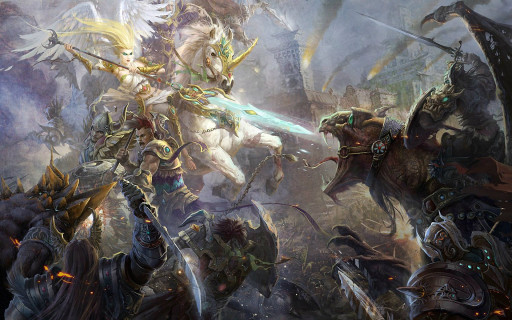
#6: A dish with variety:
Once you learn to be flexible, the next natural step is to understand that single-faction strategies do not work. Ascension rewards variety. You must be able to react to each single situation. Is there an interesting monster to defeat? Good, you have power enough to destroy it. Is there a good mechana that you could make use of? Great, acquire it.
Do not skip on killing or acquiring something just because you want t only-mechana deck, or do not skip on acquiring a mechana because you want to just kill monsters. Again, flexibility and adaptability is the key in Ascension.
#7: You have a new bible:
Yes, you absolutely have to learn by heart three things: first, the rules; second, how each card works; and third, what card combinations work the best. As the old saying suggests, “knowledge is power”. The more you know about the engine, the more efficient you can run it.
Do your homework, learn the rules, study the cards, and understand what card combinations are a killer.
#8: Be a bad guy:
What if you have nice cards, but your opponent can also have access to great ones? You don’t want that, right? In Ascension, each move will have a repercussion for you and for your opponent.
Whenever you perform an action involving the center row, you are also offering a new opportunity to your opponent to achieve something.
In this respect, before acquiring or defeating something, you should carefully think “how much this will benefit me? How much could it benefit my opponent? What could come next?”
For example, if you see in the center row a “Samael’s Trickster”, should you defeat him? You will obtain 1 victory point and 1 rune. How impactful that would be in your overall strategy? What if you defeat it and a new great card pops up for your opponent?
If you don’t defeat it, you will be denying you 3 power, that he could use for a possible bigger guy popping out after Samael’s Trickster.
#9: Action and Reaction:
Many novice players tend to play all their cards altogether. That is a terrible tactic. You don’t know what will come up new in the center deck, so it will be a waste if you play all your cards and then you regret it.
You have to be precise. Do not waste anything, and play your resources as you need them.
Acquire or defeat cards, play more resources, and keep the pace. Wasting resources will tax you over time, little by little.
#10: Keep track on the track:
It is absolutely essential that you keep track of the cards that have been shown up in the center row, so you can perform a prediction on when the big guys could come into the catwalk.
Once you reach this level, you can easily be prepared to hit hard or buy expensive things.
Always be prepared and always keep track of the things that are happening.
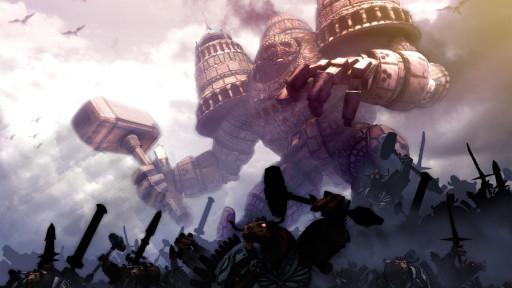
#11: An efficient engine:
When playing Ascension, pro players think about long-term efficiency. This is a key concept if you want to win a high level match. Let me explain this concept: Ascension is like the prehistoric ages: flexibility and adaptability to the environment is essential. You will not reach a far land if you cannot walk through mountains, or if you cannot hire good allies to help you, or if you cannot hunt properly.
In the other hand, during prehistoric ages, the human beings have to be efficient, but not just today. They have to take decisions taking into account two things: first, how much profit this action will report to me; and second, how much effort do I need to perform to do do that action.
Ascension falls in the same bag. Whenever you are going to perform an action such as acquiring a card or defeating a monsters, think about how much overall benefit can it offer you over the turns, and how much you have to trade off.
Usually, cards that can scale your honour, runes or power points, tend to be efficient, while cards that do not scale their benefits over time, are inefficient.
#12: The Machines are your friends:
Mechana… the faction with weird machines and crazy engineers. What could end up well from such a maddness? Well, the answer is… a lot!
Mechana is, in fact a strong faction to invest on. If you analyze their cards, you will soon realize that they are the most rune~honour efficient, in particular, their constructs, being in a ratio of 1:1.
But the thing doesn’t stop there. Mechana is a faction that relies in building-up feedback benefits. The more mechana you play, the more its power scales up, and the easiest it becomes to build up.
Of course, you should not go 100% mechana, since their utility is in many cases limited, but using Mechana as a big part of your strategy is a good idea.
#13: To flow or not to flow, that is the question:
We discussed before about maximizing your possibilities and minimizing you opponents’ Now, we should discuss further how we can take that to the next level.
In Ascension, there are a few cards that allow you to directly manipulate the center row by banishing card from it. Such is the case of Seer of the Forked Path. This card allows you to draw one card from your deck and banish a card from the center row.
This card has also been long discussed, and there is no common agreement if this is a good or bad card. In the one hand, you can negate a card for your opponent. Lets say, he is going for the monster kill strategy. You could banish a monster you don’t him to defeat. Of if he is collecting Mechana, you could destroy his strategy with the Seer.
But on the other hand, what happens if you banish a 5-cost monster in the center row, but a 7-cost monster appears, ready to be killed by your opponent?
Well, here is were you should really have into account what you learnt in #7. If you are good at keeping track of the game, you can really benefit from this type of cards.
#14: Reactive chemistry:
There are two types of players in Ascension: active and reactive.
Active players tend to take the initiative. They study the board and follow their strategy to achieve their preferred deck with the resources available.
Reactive players, in the other hand, they play to counter-act the opponent’s actions. Basically they closely track the game, and they play with probabilities. Then, they try to minimize the opponent’s chances to develop his strategy.
#15: Veni, Vidi, Vincit:
From old latin, “I came, I saw and I won”.
As you learn more and more about Ascension, you realize how important is to manage the match duration. Why this is important, you might be asking? Well, because each strategy is good at certain things. Some strategies could be good at steady, long-term honour gaining, while others could be good at acquiring honour fast and ending the match before the opponent has time to build his strategy.
It is said that pro Ascension players decide the type of strategy as soon as the very first five cards are placed on the board.
Because Ascension relies a lot on probabilities and luck factors, players should rely on that too, or at least take that into account. As soon as you see the first cards, you should already think about how to make use of then, rather than wait for better cards to come up. It could happen that those cards you wish never appear.
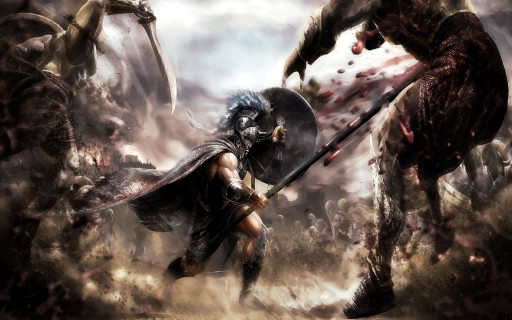
#16: Each thing in its own time:
We already discussed about efficiency. Now, I have to introduce an advanced concept that is derived directly from that, and it is “timeframe”.
Timeframe is a concept that matches efficiency and power of decision.
When you acquire or defeat a card, you should think about how efficient it is. But this level of efficiency should be compared against something. And this something is the timeframe of the match.
Lets see: in the first turn, Flytrap Witch shows up, and you have 5 runes available. Should you buy her? Definitely! This card is extremely efficient. It allows you to draw more cards, it gives you 2 honour, and it will make you gain another 2 honor again and again.
But what happens if you are in late game? This same card, Flytrap Witch, even when it is the same card, its efficiency in this timeframe is not so good. That is because in late-game, you will not have many chances to play that card. Remember, the game is almost concluding, so most likely you are spending 5 runes for a card that you could maybe use once, maybe twice to draw 2 card and earn 6 honour in total.
Then, timeframe changes efficiency, so you should consider carefully before buying or defeating any card: how much benefit could this card report me from now until the end?
#17: Return to the source:
With each expansion of the game, new monsters, heroes, constructs and a wide variety of content is added to the game to spice things up.
Many of these expansions include a new mechanic that offers players some kind of advantage in a more or less passive way. Lets say, for example, Valley of the Ancients (VotA). This expansion offers “Temples” that are always available to the players. Any player who controls any number of temples will have a clear advantage.
Why you should ignore an element of advantage? Build up an strategy around this advantage, and you shall triumph!
#18: Constructs, Constructs and Constructs:
Why the fuzz about Constructs? Well, because they are amazing! Why so? Because Constructs grant you benefits without slowing up your deck. You don’t have to keep drawing and playing then all the time. Just put them into play and that’s it. But of course, again, you have to think about time frame. Do not acquire Muramasa if the game is almost finishing.
#19: Muramasa wins the game:
Talking about Constructs, this could be possible one of the most powerful artifacts. As simple as it might be, it allows you either to kill at least one Cultist per turn, or brings you very close to killing a big dude.
You can think of it like this: “acquire 1 honour per turn, for free, or reduce the cost of any monster by 3”.
#20: Opening the Box of Pandora:
We already talked about the importance of defining your own strategy in the first turn.
And here we will go one step further: how you use your the opening hand will win or lose the game.
Yes, it might sound too radical, but it is true!
A mistake in the first turn will already encumber your next turns.
Your first hand can be either 3 Apprentices and 2 Militia; 4 Apprentices and 1 Militia; or 5 Apprentices.
What you do with those resources will heavily impact the game.
Some people like to buy a Mystic (as an investment). Other people like to buy from center row. Other people like to buy a Mystic and a Heavy Infantry. What you should do, it depends on how is the setting of the center row.
#21: A solid foundation:
Because the way of your opening (your very first turn) has so much of weight on your strategy, what should you really acquire in the first turn?
Well, nobody can really answer that question. Or if there is an answer, it would be “it depends”.
Instead, you can think of good investments that will build a solid foundation for your deck.
Cards like Arbiter of the Precipice, Arhan Initiate, Ascetic of the Lidless Eye, Temple Librarian, Wolf Shaman, Reactor Monk, Burrower Mark II, Rocket Courier X-99, Watchmaker Altar, Shade of the Black Watch or Spike Vixen, could be a good investment. The reason is simple: they offer a benefit that can easily build up, and the more you use these cards, the better. These are definitely early-game cards.
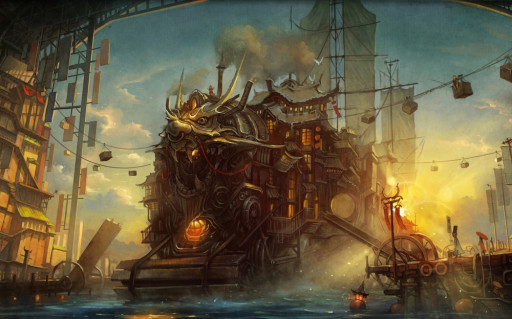
#22: Watch your step. It is full of traps!
There are several cards that, apparently, look very tempting. Lets see, for example, Void Initiate.
This guy gives you 1 rune and allows you to banish a card in hand or discard pile. With just 1 rune, there is nothing to lose. Or is it? Answer: no there is nothing to lose, but yet, nothing to win.
Lets take a closer look: in the very first turns, you will want to replace your Apprentices for Mystics, so you can boost your Rune generation. In this respect, Void Initiate does not help much. And even less when we face mid or late game.
In the other side, Void Initiate banishes one of our cards. Which is a nice thing, if you ask me, but once we are enter late game, your deck has been already shaped. There is nothing else to banish, and for sure, you don’t want to banish something valuable.
Then, Void Initiate is a card that whose efficiency is lost exponentially. The more powerful our deck becomes, the less valuable Void Initiate is.
Other cards like Mechana Initiate, Cetra, Weaver of Stars (more on this later), Druids of the Stone Circle, Arha Templar, … are usually traps, specially for late game.
#23: The strange case of Cetra, Weaver of Stars:
Do not acquire this hero. Seriously. It is a big trap. What the heck am I saying?
Sir, let me elaborate. Cetra, Weaver of Stars is a great card!
What? Am I crazy? I just say “do not acquire it”, but now I say “it is a great card”.
Yes, that is what I said. Ahem…
Remember about timeframe? Right. Then, think about this card: a 7-rune cost that allows you to put any hero on top of your deck. Nice but… If the timeframe is late game, or maybe mid game approaching late game, this Hero is a terrible investment. Look, you not only spend 7 whooping runes in a card that slows your deck, but also you might not have many chances to use its whole potential.
What If you buy it, and once you draw it, only low-cost heroes show up in the center deck? What a waste of runes and turn you did before!
So basically, do not be tempted by her amazing skill. Yes it is a great skill, but a terrible acquisition in the wrong timeframe.
#24: The trickster who might trick you:
That lamp-headed humanoid classified as Monster… Who? Yes, Samael’s Trickster. This is could be either your saviour or your worst punisher.
Let’s see: a monster that costs 3 power to defeat and rewards use with 1 honour and 1 rune. Well, by itself terrible. You can just kill a Cultist for less, and grants you the same honour.
But what is terrible about it is what you cannot read in the card. This “hidden text” says “give your opponent a new card in the center deck”. You see now where I am heading to?
Basically, be very, very aware of this little b*tch. Should you defeat it? Nobody can answer. Or if there is an answer, it will be again “it depends”. The honour rewarded is minimal. How about the rune? Well, if you are in the beginning of the game, with that extra rune you could acquire a much more powerful card that would be otherwise impossible to acquire.
Then, deciding to kill this lamb guy should be a matter of how the center row looks like.
#25: Combination and recombination:
Flexibility is a twofold strategy (like the Askara hehe). Do not play based on a single faction. Do not play thinking only turn-by-turn, and do not play cards as isolated events.
In Ascension, 99% of the cards have some kind of synergy with some other card. Here is where you should really understand every card in the game. How can the act and react, how they could improve or impede other cards. Do not underestimate the power of card combos.
#26: Cannon fodder always falls first:
And I mean that, literally. You have a limited amount of power to destroy monsters. Lets say you have 9 power. The center row has a 3 power monster and a 5 power one. Which one should you kill first? The 3 power one.
You never know what will come next. After killing that small guy, you still have 6 power left, which could be used to destroy a possible new big monster, or if not, the 5 power one.
But if you kill first the 5 power monster, you will be left with just 4 runes, which are not enough to destroy a big dude, in case it appears after your previous kill.
#27: First the killing, then the shopping:
In general terms, you should first destroy monsters, and then acquire heroes or constructs.
The reason is similar to the one explained in #26. Heroes and constructs offer you a recurring benefit, while monsters a one-time benefit. If you kill a monster, there is a chance that a new great hero or construct could pop up, better than the ones already available. Should you then give a try to your luck?
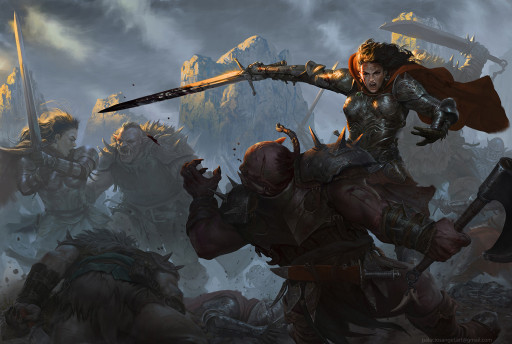
#28: Leave no options:
The difference between pro and novice players is that pro players have a high degree of adaptability and also they know how to counter the opponents’ strategy.
Being able to adapt to the situation each turn is among the basic skills you have to develop. But this will end up being useless if what you are trying to achieve is countered over and over.
If the opponent wants to go for monster killing, then, you could deny him heavy hitting heroes, or you could defeat heavyweight monsters yourself.
If the opponent is going for a Mechana-heavy tactic, then, don’t allow him to acquire the key Constructs that he needs to finish his combo or tactic.
You have always to keep track on your opponents’ movements so you can counter them.
#29: Accept only two:
Basically, if you can, play only 2 players games. 3 or 4 players games tend to be unpredictable, chaotic and extremely low chances to follow a pre-planned tactic.
Also, many strategies are completely invalid here, for example, investing in Mechana. There are too many players to make this strategy viable.
#30: Just a matter of priorities:
After discussing several times about the opening hand, it is clear that we should have clear what type of cards should be high priority when acquiring in the first turn. The priority is basically like this: first, deck banishing/thinning; card drawing; rune generation; honour generation; and power generation.
For example, if you have 5 runes your first turn, you should acquire Arbiter of the Precipice instead of Ascetic of the Lidless Eye.
The reason is simple: the benefit of getting rid useless cards is much bigger than the benefit of drawing two cards (and maybe these two cards could be useless).
#31: Protecting your assets:
In a similar way than countering your opponents’ tactics, as discussed in #28, you can use a similar approach to defend yourself from being countered.
Lets say, you are investing heavily in Constructs. If there is a monster or hero appearing in the center row that will destroy your artifacts, you should be prepared. Cards that allow you to banish other cards from the center row are a good option, so you can eliminate that threat.
#32: Keep secrets secret:
Many times happens that after you purchase and/or defeat cards in the center row, you end up with one or two hands left in hand that even if you play it, you cannot do anything. In this case, do not play them. This specially true if you are playing against a human.
Why do not play them anyway? Well, because you don’t want to let your opponent know what cards you played or not, so they cannot properly assess what is your military power next turn or what cards could be on your hand.
The best tactic is always do not let you opponent know what you can do.
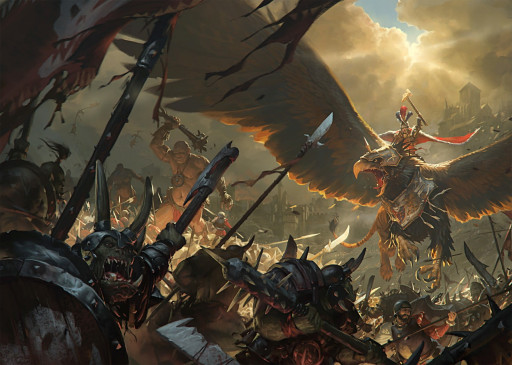
#33: To be or not to be…
When banishing cards from your hand or discard pile, first banish militia, then apprentice. That is because with apprentice you can still acquire much powerful cards. If you cannot have a consistent amount of runes per turn, you will get stuck. If you cannot defeat a monster one turn, you will lose nothing.
#34: Assets as a medium, not the goal:
Basically, you should not acquire too many cards of each type, unless they are constructs.
Cards allow you to react to certain situations, or make your deck more efficient, or accelerate your turns.
If you get too many card-drawing cards, you are not obtaining much benefit, just drawing another card that allows you to draw a card. What is the goodness about that?
In the other hand, if you buy too many mystics or too many rune generation heroes, you might have lots of runes, but when it comes to practicality, there is not much more you can do in your turn.
#35: Honour changes it all:
The same as the cards in the center row, the amount of honour available to the players from the beginning of the game changes things.
With a big pool of honour, long term investment strategies are preferred.
In this case, if you are not able to develop this strategy, your best bet is to try to deplete the honour pool as fast as possible. To do so, go for monster killing or honour-granting cards.
#36: Make it stronger and stronger:
In Ascension, you should have a mindset of “each turn I will make it bigger”.
What I mean is, each turn you should think about the card or cards that will make your deck stronger. Whenever you acquire or defeat a card, think carefully: will that card, in combination with what I already have, make my deck be stronger? Will that card bring me closer to what I want?
Do not acquire a card just because it is good. Cards never play isolated, so that card might be weak in your deck.
#37: Poor guy, Arha Templar:
This card is just a representative example of a bad card.
Sure, the illustration looks cool, it is cheap, it gives some honour points, and it can kill some enemies for free.
But that is the problem. He can kill only weak enemies. And usually weak enemies are killed in the blink of an eye. Once you draw Arha Templar, it might easily not be any 4-power or less enemy left to destroy!
Basically, Arha Templar is a card that goes against the rule of “cards that scale their power, rune or honour generation”. Do not acquire these type of cards!
#38: Enlightened for the fast:
Enlightened faction is the faction that manipulates time and shapes reality.
Basically they are focused in drawing cards, giving extra turns, discarding cards, and overall shaping your deck.
Always have some enlightened heroes or constructs in your deck.
#39: Lifebound, for the teamwork:
Lifebound faction is a jack of all trades. They perform fairly well in several things, and if you want, they are good at generating honour without killing enemies.
Also, they are good at synergy. Many lifebound cards will trigger an extra benefit if player among with other lifebounds.
Depending on your play style, you could skip this faction, but still, some of their heroes worth considering because of the synergy of their cards.
#40: Mechana, the growing snowball:
This faction is mostly designed to work independent from others. Most of the benefits you acquire from them will feedback themselves, and that is why many players call them “the snowball faction”, because these benefits keep building up, making this easier for Mechana faction.
It is advised to invest, at least, a bit in this faction.
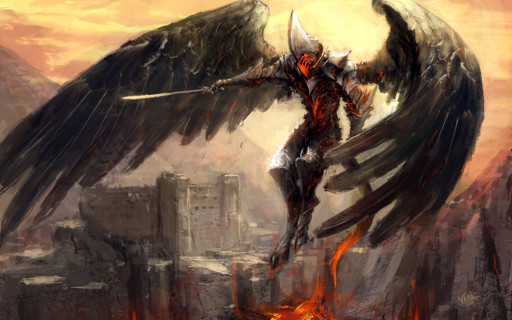
#41: The Void, be always aware:
Void faction, the guys who are born for combat and destruction.
Acquiring cards from this faction will grant you two things: one, combat power, and second, deck efficiency, from a banishing point of view.
Most of these cards will give you combat power, so you can defeat enemies.
Many others will also allow you to banish cards from your hand and/or discard pile.
But sadly, most of these cards are not good at creating combos. They just do what they are designed to do, and nothing else.
Anyway, having Void cards in your deck is essential.
#42: The rule of 4:1…
The worst opening hand you can have could easily be 4 Apprentices and 1 Militia.
Unless there is something really good in the center row, you will have to buy just a Mystic.
Then you will be left with 1 rune and 1 power that you cannot use for absolutely anything.
#43: The free militia.
It would be ideal to play cards that, once played, they are replaced automatically by others from your deck, and besides that, they offer some kind of benefit.
Well, this is the case of Spike Vixen. This is a must for monster-defeating strategies.
When you play Spike Vixen, you get 1 point of power, and you draw a card, so basically it is as if you are not losing one card draw.
#44: Deep, dig deeper!
Burrower Mark II is an absolute must for any Mechana deck.
This card greatly accelerates your card drawing, it doesn’t occupy space in your deck, and it allows you to recover faster from situations like “Sea Tyrant”.
#45: The free apprentice.
Now that you know about Spike Vixen, how about if you could have similar effect, but with runes, instead of power? Do not search further. That is the case of Wolf Shaman: 1 rune plus draw a card.
#46: Do you like werewolves?
Sometimes I like them, some other times, I don’t.
This is the case of Runic Lycanthrope. This hero in its most basic way, is a Mystic. It costs 3 runes, and gives you 2.
But, if you played before other lifebound hero before, it will also grant you 2 power.
If you are investing in lifebound cards, then this is a good acquisition. Otherwise, not really.
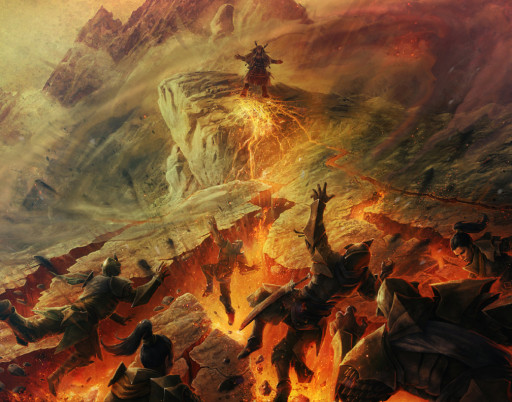
#47: Be greedy.
While the game is still in its early moments, just be greedy, and specially about Constructs.
Constructs are an amazing way to obtain a permanent advantage. It doesn’t mind if your strategy is monster focused or Mechana focused. Constructs will offer you also a lot of flexibility spans a huge range of benefit types. Why you should reject being prepared for any kind of situation?
#48: David or Goliath?
When you are in the very first turns of the game, many times you are faced with a dilemma: should I acquire this big hero now, or should I get other rune-generating hero?
If you really understand the game, this question should not come up in your mind.
Always acquire the big hero. Because you are in the beginning of the game, there will be many opportunities for that hero to be used, and you can acquire rune-generating heroes anytime.
#49: Rinse and repeat:
Practise turns novices into masters.
Practise over and over. Apply all the strategies in this guide, and see how they work for you.
It is very likely the AI opponents become too easy for you so soon.
Once that happens, make the jump and fight against human opponents.
Most likely you will lose often in the beginning. Do not get discouraged. They know more than you and have more experience.
Learn about their actions and reactions.
#50: Everything about agility
If you can, join or create a match with the least minimum amount of time per player. This constrain will enhance your reflexes, your capacity to think fast, to learn more, to assess and understand things faster.
In the end, the player who is able to understand better and faster, will be the victorious.
Conclusion:
Ascension, as simple as it seems to be is, in fact, a surprisingly deep game, with a strong set of rules, and an incredible replayability value.
Do not be fooled by its apparent simplicity.
If you really want to utterly destroy your opponents, you should study carefully about the game, the best tactics and how to become efficient in each single turn.
With this list of the best tips for pro-playing, I hope you can start boosting your performance and having a closer look to, ultimately, develop your own strategy to beat anyone.
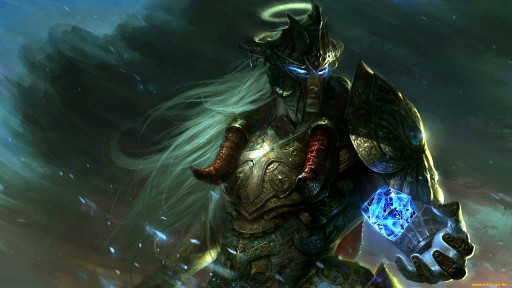
You may also be interested in:

